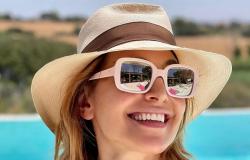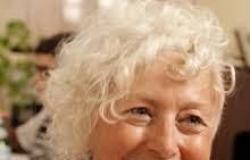“Hido” is the stage name of Samuele Di Felice, a painter born in Chiavari in 1981 who makes ancient Greek and Roman mythology his artistic signature. Classical subjects are for him symbolic structures through which to reflect on contemporary themes, containers that the artist himself modifies using various techniques. Hido’s works reflect that mystical, spiritual and in some cases esoteric element that contemporary society ignores. Each work is born with a precise message, which however finds its fulfillment in the free interpretation of the observer. Between 2017 and 2022 Hido exhibited both in Tigullio and outside Liguria (Rome, Milan, Padua, Pavia) and abroad (Zagreb, Amsterdam, Copenhagen, Paris, Dubai). We met him in the studio-laboratory in Corso Buenos Aires in Lavagna, surrounded by some of his most significant works.
When did you start painting? “Like everyone, I started painting as a child. For a long period, from the end of high school to the age of thirty I cultivated other types of art – opera singing, theatre, performances in general – and then resumed with ‘my first love’, namely painting and the graphic art of whose approach I have explored in depth, I define it, and with this term I mean a series of different techniques that I have cultivated over the years and which ensure that the individual works differ from each other, because different techniques have been used depending on the emotion expressed in the painting”.
Did you attend specific schools or courses? “I have never attended art schools or painting courses. I am self-taught but a child of art: my aunt teaches at the Academy of Fine Arts in Bergamo, my mother has been a painter all her life, my uncle designed for various Italian brands. No one has ever taught me to paint, an art school was not chosen for me but I have always breathed art, form, color, which allowed me to be familiar with the gesture and passion for art”.
Why did you choose “Hido” as your stage name? “It’s an ancient name, it dates back to the period in which I did improvisation-based theater and my character was called that. He became a sort of superego or ‘artistic me’, because it was you yourself who met with the other subjects in this sort of theatrical bubble. Since then ‘Hido’ has remained my name in art, it is a second name that I gave myself”.
What is the meaning of the reference to classical art figures? “Since I was a boy I have always really liked the epic, I have always been fascinated by the concepts of love, passion, emotion, divinity, sacred, religious, the supernatural. Very wise concepts expressed in a symbolic way so that they remain over time. I have always loved god figures for what they represent and how they can be used to communicate something. To give an example, during the pandemic I created a very large work depicting the god of medicine, Asclepius, with the Hippocratic Oath inside his figure. I donated this work to the Lavagna hospital, with the intention of donating it to healthcare as a whole to give honor and credit to the doctors who at that moment were honoring that oath and that mission they had chosen, doing everything possible to resolve a complicated situation, but also to remind as a warning to doctors who were not doing what they had sworn. This is to say how the classical figure works very well in modern communication of reflection, remaining delicate but deeply inserted into culture, because they are divinities that we all know. They are simple symbols to understand as a meaning, on which one can go and do fine work on all those Greco-Roman concepts that the world of mythology has transmitted to us”
What messages do you want to convey with your works? “The profound theme of my art is humanistic, I am an artist of man, for man, a fact that leads me to have pleasure in sharing my experiences, my emotions. The general theme is always a reflection on something that happened to me or in society, placing an accent, a question mark. Alongside this there is a lot of technical research, that is, the concrete and material approach to the work as a basis for communicating. I use a correct approach to chemistry which I carry over into the artistic subject; this is an aspect that I love. To give another example, in the case of the painting of the Three Graces this approach is particularly important: the material background (cement, sand and quartz crystals) was caramelized with a chemical fire and painted with sulfuric acid in solution with acrylic. The two founding points of my production are the humanistic and the technical aspects”.
Explain the techniques used. “I use acrylic colours, including enamel, therefore synthetic, combined with sand, lapis lazuli, quartz, cement, plastic alloys, polyurethane”
How did you learn them? “The various combinations are the result of daily experiments. Spreading sulfuric acid over the acrylic to remove the water base, with the corrosion effect, no one teaches you this, you learn by doing, starting from mentally identifying the emotion I feel and want to express. For this reason, before working on the painting, rather than giving drafts, I write the feeling or sensation I want to create. For example, I am now studying to make a jellyfish and for the jellyfish look I ordered scapolite, a basic luminescent mineral. I came up with the idea of a petrifying gaze, I can render it with beams of light that hit it. But it’s too complex, you should always keep the power connected, it’s not simple enough. So I researched the chemical element, the crystal that works best; I identified four/five and then chose based on the best quality/price ratio”.
A work or works that best represent your art. “For me all my works are, ‘they are all my children’, it is difficult to choose. Among the paintings that were exciting for me to experience, make and see created, there is certainly the “Divinification of Hercules”, which is the result of a long process. Under the blue of Hercules’ face there was a painting with colors of red, brown, black, gold which represented a man on his knees with a skeletal angel who kissed him like an angel of death. That was a moment during the pandemic when I felt a sensation of crushing, of suffocation. At that time my father couldn’t work and so he came to my studio and, since we had time, we took long walks on the Entella, during which we talked. So I experienced these beautiful moments with my father that wouldn’t have happened if there hadn’t been the lockdown. They were moments that made me feel healed, as if there was a divine light inside me. From this comes the blue face that I overwrote over the previous painting and which I attributed to Hercules, the hero of the Twelve Labours. It was giving shape to an effort that then found its own dimension of rebirth, like a star in the sky.”
Where will you have your next exhibition? “I had my last exhibition in Dubai about a month ago. The idea is to return to Dubai, where in conjunction with a contemporary art fair an art gallery organized a collective exhibition of about ten Italian artists, among which I was.”
When you started did you think you would exhibit abroad? “A few years ago, when I started small exhibitions, I had the desire to exhibit at the Moma in New York. So I really started with this idea. I was already seeing things big!”.





